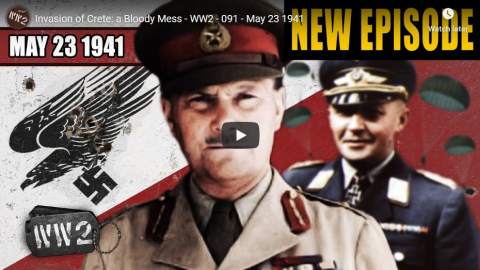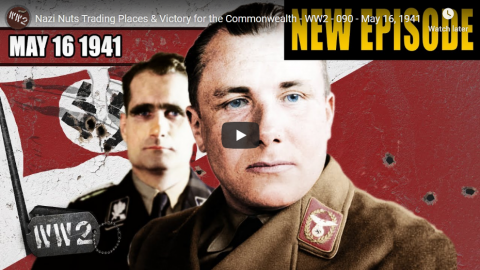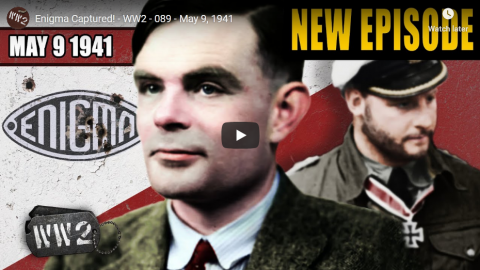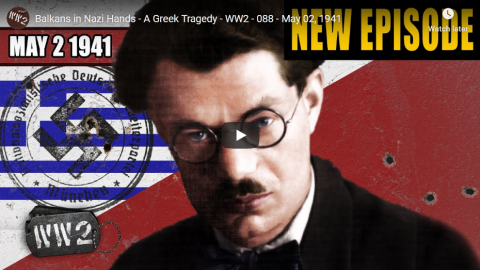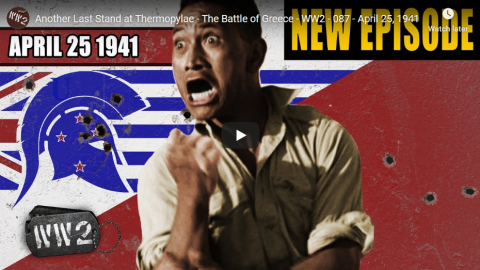World War Two
Published 30 May 2020This week, the Battle of Crete continues as the Bismarck and Prinz Eugen set sail to the Atlantic, starting one of the most dramatic episodes in the histories of the Royal Navy and the Kriegsmarine.
Join us on Patreon: https://www.patreon.com/TimeGhostHistory
Or join The TimeGhost Army directly at: https://timeghost.tvFollow WW2 day by day on Instagram @World_war_two_realtime https://www.instagram.com/world_war_t…
Between 2 Wars: https://www.youtube.com/playlist?list…
Source list: http://bit.ly/WW2sourcesWritten and Hosted by: Indy Neidell
Director: Astrid Deinhard
Producers: Astrid Deinhard and Spartacus Olsson
Executive Producers: Astrid Deinhard, Indy Neidell, Spartacus Olsson, Bodo Rittenauer
Creative Producer: Joram Appel
Post-Production Director: Wieke Kapteijns
Research by: NN
Edited by: Iryna Dulka
Sound design: Marek Kamiński
Map animations: Eastory (https://www.youtube.com/c/eastory)Colorizations by:
– Norman Stewart – https://oldtimesincolor.blogspot.com/
– Daniel Weiss
– Jaris Almazani (Artistic Man), https://instagram.com/artistic.man?ig…
– Carlos Ortega Pereira, BlauColorizations, https://www.instagram.com/blaucoloriz…Sources:
– Imperial War Museum: A 6152, A 6155, A 3898, IWM A4057, HU 50190, HU 374, FL 2120, E 3464, E 450
– U.S. Naval History and Heritage Command Photograph
– Narodowe Archiwum Cyfrowe
– Drawing of Churchill from Museon
– Battlecruiser Renown shape by Emoscopes from WikimediaArchive by Screenocean/Reuters https://www.screenocean.com.
A TimeGhost chronological documentary produced by OnLion Entertainment GmbH.
May 31, 2020
Sink the Bismarck! – The Pride of the Kriegsmarine‘s Demise – WW2 – 092 – May 30 1941
May 24, 2020
Invasion of Crete: a Bloody Mess – WW2 – 091 – May 23 1941
World War Two
Published 23 May 2020Operation Mercury commences as fallschirmjäger airborne troops land on the Greek island of Crete. A bloody and messy battle follows as it turns out to be costly in more ways than one.
Join us on Patreon: https://www.patreon.com/TimeGhostHistory
Or join The TimeGhost Army directly at: https://timeghost.tvFollow WW2 day by day on Instagram @World_war_two_realtime https://www.instagram.com/world_war_t…
Between 2 Wars: https://www.youtube.com/playlist?list…
Source list: http://bit.ly/WW2sourcesWritten and Hosted by: Indy Neidell
Director: Astrid Deinhard
Producers: Astrid Deinhard and Spartacus Olsson
Executive Producers: Astrid Deinhard, Indy Neidell, Spartacus Olsson, Bodo Rittenauer
Creative Producer: Joram Appel
Post-Production Director: Wieke Kapteijns
Edited by: Iryna Dulka
Sound design: Marek Kamiński
Map animations: Eastory (https://www.youtube.com/c/eastory)Colorizations by:
– Julius Jääskeläinen – https://www.facebook.com/JJcolorization/
– Dememorabilia – https://www.instagram.com/dememorabilia/
– Norman Stewart – https://oldtimesincolor.blogspot.com/
– Jaris Almazani (Artistic Man), https://instagram.com/artistic.man?ig…
– Carlos Ortega Pereira, BlauColorizations, https://www.instagram.com/blaucoloriz…Sources:
– Imperial War Museum: A 28473, E 3064E, A 4154, A 4153, A 4149, A 4144, E 3066E, E 3023E, A 4156, E 6066
– Archives municipales de Brest
– Museums Victoria
– Bundesarchiv, CC-BY-SA 3.0: Bild_141-0816, Bild_183-L04232, Bild_101I-166-0527-10A, Bild 101I-166-0527-22 / Weixler, Franz Peter, Bild_183-L19019, Bild 146-1977-115-04, Bild 141-0823, Bild_101I-166-0512-39, Bild_146-1981-159-22, Bild_146-1980-090-34, E 3022EArchive by Screenocean/Reuters https://www.screenocean.com.
A TimeGhost chronological documentary produced by OnLion Entertainment GmbH.
May 17, 2020
Nazi Nuts Trading Places & Victory for the Commonwealth – WW2 – 090 – May 16, 1941
World War Two
Published 16 May 2020In the week that Rudolf Hess makes his flight to Britain, the Luftwaffe prepares for theirs to Crete. The British utilise their code-breaking methods and prepare for defence.
Join us on Patreon: https://www.patreon.com/TimeGhostHistory
Or join The TimeGhost Army directly at: https://timeghost.tvFollow WW2 day by day on Instagram @World_war_two_realtime https://www.instagram.com/world_war_t…
Between 2 Wars: https://www.youtube.com/playlist?list…
Source list: http://bit.ly/WW2sourcesWritten and Hosted by: Indy Neidell
Director: Astrid Deinhard
Producers: Astrid Deinhard and Spartacus Olsson
Executive Producers: Astrid Deinhard, Indy Neidell, Spartacus Olsson, Bodo Rittenauer
Creative Producer: Joram Appel
Post-Production Director: Wieke Kapteijns
Edited by: Iryna Dulka
Sound design: Marek Kamiński
Map animations: Eastory (https://www.youtube.com/c/eastory)Colorizations by:
– Norman Stewart – https://oldtimesincolor.blogspot.com/
– Olga Shirnina, a.k.a. Klimbim – https://klimbim2014.wordpress.com/
– Daniel Weiss
– Carlos Ortega Pereira, BlauColorizations – https://www.instagram.com/blaucoloriz…
– Dememorabilia – https://www.instagram.com/dememorabilia/Sources:
– Imperial War Museum: E2623, E 3222, E 3237, E 3233, E 3238, E 3228,
– Bundesarchiv, CC-BY-SA 3.0: Bild 183-R14128A, B 145 Bild-F016230-00007, Bild 141-0864, Bild 183-L19017
– National Portrait Gallery
– Artillery by Creative Mania from the Noun Project
– Oil barrel by Musmellow from the Noun Project
– Narodowe Archiwum Cyfrowe
– Photo from Bletchley Park, Sourse: Bletchley Park Trust
– Photo of Battista Volpini courtesy La StampaArchive by Screenocean/Reuters https://www.screenocean.com.
A TimeGhost chronological documentary produced by OnLion Entertainment GmbH.
May 10, 2020
Enigma Captured! – WW2 – 089 – May 9, 1941
World War Two
Published 9 May 2020An Enigma encode is captured in the Atlantic Ocean as the Germans make plans for a new offensive in Crete. Britain is heavily bombed by the Luftwaffe and fighting continues in Iraq, China and East-Africa.
Join us on Patreon: https://www.patreon.com/TimeGhostHistory
Or join The TimeGhost Army directly at: https://timeghost.tvFollow WW2 day by day on Instagram @World_war_two_realtime https://www.instagram.com/world_war_t…
Between 2 Wars: https://www.youtube.com/playlist?list…
Source list: http://bit.ly/WW2sourcesWritten and Hosted by: Indy Neidell
Director: Astrid Deinhard
Producers: Astrid Deinhard and Spartacus Olsson
Executive Producers: Astrid Deinhard, Indy Neidell, Spartacus Olsson, Bodo Rittenauer
Creative Producer: Joram Appel
Post-Production Director: Wieke Kapteijns
Edited by: Iryna Dulka
Sound design: Marek Kamiński
Map animations: Eastory (https://www.youtube.com/c/eastory)Colorizations by:
– Julius Jääskeläinen – https://www.facebook.com/JJcolorization/
– Olga Shirnina, a.k.a. Klimbim – https://klimbim2014.wordpress.com/
– Carlos Ortega Pereira, BlauColorizations, https://www.instagram.com/blaucoloriz…
– Adrien Fillon – https://www.instagram.com/adrien.colo…
– Dememorabilia – https://www.instagram.com/dememorabilia/Sources:
– Narodowe Archiwum Cyfrowe
– Bundesarchiv, CC-BY-SA 3.0: Bild 101I-769-0229-10A / Borchert, Erich (Eric), Bild 101I-317-0053-18 / Amphlett, Eduard, Bild_101I-567-1523-38, Bild 141-0853, Bild_146-2006-0188
– Micheal Hörenberg, Uferstr. 29, D-78343 Hemmenhofen
– Imperial War Museum: E 6822, AUS 897, E 4791, E 3040E, E 3042E, E446, E 3025E, E 1164, E 1172, E 3020E, E 2182,
– Ju 52 graphic by TSRL from Wikimedia
– DFS 230 and Ju 87 graphics by Kaboldy from WikimediaArchive by Screenocean/Reuters https://www.screenocean.com.
A TimeGhost chronological documentary produced by OnLion Entertainment GmbH.
May 3, 2020
Balkans in Nazi Hands – A Greek Tragedy – WW2 – 088 – May 02, 1941
World War Two
Published 2 May 2020Greece falls as Axis troops push through the last Allied defences. New plans are made for a German invasion of Crete, and a new war breaks out between Great Britain and Iraq.
Join us on Patreon: https://www.patreon.com/TimeGhostHistory
Or join The TimeGhost Army directly at: https://timeghost.tvFollow WW2 day by day on Instagram @World_war_two_realtime https://www.instagram.com/world_war_t…
Between 2 Wars: https://www.youtube.com/playlist?list…
Source list: http://bit.ly/WW2sourcesWritten and Hosted by: Indy Neidell
Director: Astrid Deinhard
Producers: Astrid Deinhard and Spartacus Olsson
Executive Producers: Astrid Deinhard, Indy Neidell, Spartacus Olsson, Bodo Rittenauer
Creative Producer: Joram Appel
Post-Production Director: Wieke Kapteijns
Edited by: Iryna Dulka
Sound design: Marek Kamiński
Map animations: Eastory (https://www.youtube.com/c/eastory)Colorizations by:
– Olga Shirnina, a.k.a. Klimbim – https://klimbim2014.wordpress.com/
– Julius Jääskeläinen – https://www.facebook.com/JJcolorization/
– Dememorabilia – https://www.instagram.com/dememorabilia/
– Carlos Ortega Pereira, BlauColorizations, https://www.instagram.com/blaucoloriz…Sources:
– Bundesarchiv, CC-BY-SA 3.0, Bild_146-1977-163-05A, Bild 146-1977-122-16, Bild_141-0816, Bild 101I-757-0023-32
– National Portrait Gallery
– Imperial War Museum: Q 69840, HU 52264Archive by Screenocean/Reuters https://www.screenocean.com.
A TimeGhost chronological documentary produced by OnLion Entertainment GmbH.
From the comments:
World War Two
2 days ago (edited)
Now, we have decided to leave out any Call to Action (the bit where Indy tells you to subscribe and support us on Patreon) to give room to the dramatic speech on Radio Athens. So allow me to write it right here: If you want to learn more about how Kurt Student’s Fallschirmjäger were developed and used earlier in the war, you can check out our Special Episode about that right here: https://youtu.be/RNr3E3Hr0bo. I don’t want to deny anyone the chance to get a random name shoutout in the video by writing it here, but it is thanks our supporters that we can continue to make content like this. You can join the TimeGhost Army on www.patreon.com/timeghosthistory or https://timeghost.tv. Don’t forget to subscribe, ring the notification bell and see you next time!
Cheers, Joram
April 26, 2020
Another Last Stand at Thermopylae – The Battle of Greece – WW2 – 087 – April 25, 1941
World War Two
Published 25 Apr 2020The Battle of Greece continues as forces clash once more at the historic site of Thermopylae.
Join us on Patreon: https://www.patreon.com/TimeGhostHistory
Or join The TimeGhost Army directly at: https://timeghost.tvFollow WW2 day by day on Instagram @World_war_two_realtime https://www.instagram.com/world_war_t…
Between 2 Wars: https://www.youtube.com/playlist?list…
Source list: http://bit.ly/WW2sourcesWritten and Hosted by: Indy Neidell
Director: Astrid Deinhard
Producers: Astrid Deinhard and Spartacus Olsson
Executive Producers: Astrid Deinhard, Indy Neidell, Spartacus Olsson, Bodo Rittenauer
Creative Producer: Joram Appel
Post-Production Director: Wieke Kapteijns
Edited by: Iryna Dulka
Sound design: Marek Kamiński
Map animations: Eastory (https://www.youtube.com/c/eastory)Colorizations by:
– Norman Stewart – https://oldtimesincolor.blogspot.com/
– Jaris Almazani (Artistic Man), https://instagram.com/artistic.man?ig…
– Julius Jääskeläinen – https://www.facebook.com/JJcolorization/
– Dememorabilia – https://www.instagram.com/dememorabiliaSources:
– Bundesarchiv, CC-BY-SA 3.0, Bild 101I-163-0318-09/Bauer, Bild 101I-163-0319-03A/Bauer
– Edo leitner from Wikimedia
– Imperial War Museum: E 3830, TR 1762, IWM ART LD 3355, E 676, E 3182, E 3187, E 3178, E 3183, E 2363
– Roll by rivercon from the Noun Project
– Grains by Gan Khoon Lay from the Noun ProjectArchive by Screenocean/Reuters https://www.screenocean.com.
A TimeGhost chronological documentary produced by OnLion Entertainment GmbH.
From the comments:
World War Two
2 days ago (edited)
The war keeps on growing, and were doing our best to keep up with it. As you notice the episodes are often longer these days, but there are still many details we just can’t cover in the weekly episodes for time reasons. That’s why we do our specials and also why we have our Instagram and Facebook feed with headlines of the war day by day. For instance, while we cover the Allied retreat at Thermopylae, Indy just didn’t have space to go into the details about how Australian and New Zealand forces hold back the Wehrmacht while the others retreat. That will instead be the topic of our post on Instagram / Facebook on April 24 here: https://www.instagram.com/world_war_two_realtime/ and on the TimeGhost facebook page. We also dedicated the thumb to that event by featuring a soldier of the 28th (Māori) Battalion of the NZ forces, photographed in North Africa somewhat later in 1941 while doing the Haka. His unit was part of the rear guard at Thermopylae.And on that note we would like to acknowledge that we would never be able to do this massive endeavor without the TimeGhost Army and their financial contribution. Valantis who supported this episode by dedicating it to the Cypriots fighting for the Allies in the war is not only a member of the TG Army, he’s also a valuable contributor in our comment sections and volunteers his time to help us sift through and read every comment posted under any of our videos. So, in this place we would like to once again thank Valantis and the entire TimeGhost Army for keeping us in kit, supplies, and manpower to continue the good fight for remembrance and education, especially in these trying times. You can join our forces here https://www.patreon.com/TimeGhostHistory or here https://timeghost.tv
Spartacus on behalf of the entire TimeGhost team.
March 13, 2020
Fallschirmjäger – Germany’s Finest – WW2 Special Episode
World War Two
Published 12 Mar 2020The Fallschirmjäger were Germany’s own paratrooper branch, designed to deal a swift and fatal blow behind the enemy’s lines. They were deployed with great success in Scandinavia and the Benelux, but they come too close to the sun when they attempt to invade Crete.
Join us on Patreon: https://www.patreon.com/TimeGhostHistory
Or join The TimeGhost Army directly at: https://timeghost.tvFollow WW2 day by day on Instagram @World_war_two_realtime https://www.instagram.com/world_war_t…
Between 2 Wars: https://www.youtube.com/playlist?list…
Source list: http://bit.ly/WW2sourcesHosted by: Indy Neidell
Written by: Joram Appel and Izzy Wilson
Produced and Directed by: Spartacus Olsson and Astrid Deinhard
Executive Producers: Bodo Rittenauer, Astrid Deinhard, Indy Neidell, Spartacus Olsson
Creative Producer: Joram Appel
Post-Production Director: Wieke Kapteijns
Research by: Joram Appel and Izzy Wilson
Edited by: Mikołaj Cackowski
Map animations: Eastory (https://www.youtube.com/c/eastory)
Sound design by: Marek KaminskiColorizations by:
Julius Jääskeläinen – https://www.facebook.com/JJcolorization/
Ruffneck88 – https://commons.wikimedia.org/wiki/Fi…Sources:
IWM E 3066ESoundtracks from the Epidemic Sound:
Rannar Sillard – “March Of The Brave 4”
Reynard Seidel – “Deflection”
Rannar Sillard – “Easy Target”
Gunnar Johnsen – “Not Safe Yet”
Johannes Bornlof – “Last Man Standing 3”
Fabien Tell – “Last Point of Safe Return”Archive by Screenocean/Reuters https://www.screenocean.com.
A TimeGhost chronological documentary produced by OnLion Entertainment GmbH.
From the comments:
World War Two
1 day ago
This is the first of many proper specials that we want to do to add on the weekly World War Two episodes, the War Against Humanity series, the Biographies, our Out of the Foxholes Q&A series and our upcoming On the Homefront sub-series. In these specials, we’ll cover any additional topics in depth — think about hardware, tactics, special forces, bills or decryption systems. We’re interested to hear your suggestions! What do you want to see covered in an upcoming special epsiode?
January 16, 2020
Book Review: The Ministry of Ungentlemanly Warfare by Damien Lewis
Forgotten Weapons
Published 24 Sep 2017Get your copy on Amazon: http://amzn.to/2xwfDZ8
I ordered a copy of Damien Lewis’ book on the exploits of British SOE in WWII expecting to find an overview of, well, what SOE had done during the war. That’s not quite what this book is. Instead, Lewis has given us essentially a first-person view of SOE’s work through the eyes of Danish commando Anders Lassen (VC, MC with two bars). Don’t be fooled by the cover image; the North African LRDG is never mentioned. However, what Lassen was involved in was equally impressive and probably less well known.
Lassen was part of the crew for the first real SOE operation, the theft of a pair of German and Italian supply ships from the neutral Spanish port at Fernando Po. In an exploit that could be straight out of Hollywood, a band of commandoes sailed a pair of tugboats into the harbor at night while the ships’ officers were ashore at a raucous party. They blew the anchor chains with explosive charges, locked the crews below deck, and sailed the ships out to sea where they could be legally captured by a British destroyer. And they did it without a single death on either side.
The exploits only became bigger and bolder after that, with Lassen and his comrades making regular raids across the English Channel and running a freewheeling campaign of both hit-and-run raids and occupation of Greek islands in the Aegean. These were the quintessential independent Special Forces fighters, operating outside regular military command structures and supply chains, fighting as they saw fit. Lassen eventually became the commanding officer of a large group, and by the end of the war had been awarded the Military Cross three times. His last operation in Italy — where his men were hit with a shattering defeat when pushed into the role of spearheading a conventional offensive — would result in him posthumously receiving the Victoria Cross for his heroism.
I ended up reading the book almost entirely in a single sitting, and found it riveting and fascinating — far more so than the typical academic history. It offers a humbling and motivating example of what men can do when they are skilled and motivated. At the same time, it also left me a bit melancholy, as by the end we can see Lassen consumed by his combat experiences and slowly becoming removed from society. Nobody can say how Lassen would have coped had he survived the war, but one suspects he would have led a troubled life. Perhaps that is the price one must pay to become, as Churchill described, “a hand of steel which plucks the German sentries from their posts with growing efficiency.”
http://www.patreon.com/ForgottenWeapons
Cool Forgotten Weapons merchandise! http://shop.bbtv.com/collections/forg…
If you enjoy Forgotten Weapons, check out its sister channel, InRangeTV! http://www.youtube.com/InRangeTVShow
August 11, 2019
QotD: Deconstructing “Minoan Crete”
In many ways, “Minoan” Crete seemed like a Freudian paradise. Here the archaeologists unearthed colourful frescoes of naked-breasted women participating in the dangerous “bull-vaulting” game, whilst statuettes of bare-breasted goddesses, holding writhing snakes in each hand, emerged from various parts of the island. Evans spoke glowingly of a pacifist matriarchy that flourished before the coming of the warlike and patriarchal Greeks, and his vision was hugely influential in academic circles for at least half a century. It is a vision which has been humorously outlined by Rebecca Bradley on the dust-cover of her book, Goodbye, Mother: The Warriors of Crete: “Once upon a time, on an olive-strewn island in a wine-dark sea, beautiful people lived in peace under the rule of the Great Goddess and her matriarchal avatars. The like of their palaces was not seen again until the advent of shopping-mall architecture in the twentieth century; their artistry flowered like the saffron blossoms collected by their luscious bare-breasted maidens. This was Minoan Crete, stronghold of the Matriarchy and the Great Goddess, flower child of the ancient world — until those nasty patriarchal Mycenaeans and even nastier Dorians came along and crashed the party. Oh yes, and there’s something about a volcano on Santorini, and a few earthquakes as well, but the rot really set in when the men from the mainland took over.”
Perhaps the most prominent high priestess of the Great Goddess was Lithuanian archaeologist Marija Gimbutas (1921-1994). During the 1950s and 60s Gimbutas developed her so-called “Kurgan Thesis;” basically the idea that the archaeological marker of the arrival in Europe of Indo-European-speakers was to be found in the Bronze Age Kurgan mound burials of the Pontic Steppe, a vast region incorporating most of present-day Ukraine, southern Russia and northern Kazakhstan. Controversially, Gimbutas further claimed that these nomadic Indo-Europeans brought with them a warrior-culture dominated by male sky-gods, which supplanted earlier matriarchal and goddess-worshipping cultures. In this, she echoed ideas already expressed at great length by Robert Graves in his 1948 book The White Goddess. Over the next three decades Gimbutas developed her ideas further in a series of books, articles and lectures delivered at campuses throughout America and Europe, where she was immensely influential amongst the burgeoning women’s movement. Three major works, The Goddesses and Gods of Old Europe (1974), The Language of the Goddess (1989), and The Civilization of the Goddess (1991), presented an overview of her conclusions regarding what she saw as Europe’s primeval matriarchy.
The importance of Gimbutas in the development of the matriarchal myth, and also by extension in the development of modern radical feminism, cannot be overstated. Her archaeological experience and expertise, together with her wide knowledge of linguistics and anthropology, seemed to give academic credibility to the romantic and poetic ramblings of Arthur Evans and Robert Graves. Yet in retrospect it is hard to imagine why anyone with even a modicum of common sense could have been taken in.
There were warning signals everywhere. Right from the beginning, for example, many historians were critical of Evans’ interpretation of Minoan Crete, and a devastating blow was delivered in 1974 when German author Hans Georg Wunderlich published his Wohin der Stier Europa trug? (Where did the Bull carry Europa? published in English in 1975 as The Secret of Crete). Here Wunderlich, a trained geologist, examined the structure of the “palace” of Knossos in Crete in detail and came to the conclusion that the building could never have been a palace for the living. It was, instead, a charnel house, a massive necropolis which doubled as an arena for human sacrifice. For the happy-go-lucky “bull vaulting game”, said Wunderlich, was nothing of the sort: it was a ferocious form of human sacrifice which involved young men and women being gored and trampled to death by a sacred bull. This, said Wunderlich, was the origin of the legend of the Minotaur. Since Wunderlich’s time human sacrifice has been confirmed as an integral part of Cretan religious practice, whilst the supposed “pacifism” which Evans and others had imagined, was exposed as nonsensical.
Emmet Scott, “The Myth of the Primeval Matriarchy”, The Gates of Vienna, 2016-07-13.
May 16, 2019
Bronze Age collapse
archeo atlas
Published on 3 Jan 2014The Influence of Climatic Change on the Late Bronze Age Collapse and the Dark Ages
March 4, 2018
QotD: Rousseau’s “Noble Savage” myth
The concept of a primeval matriarchy may be regarded, on one level, as a modern incarnation of the Golden Age myth, a belief found in primitive societies throughout the world that during the infancy of the human race mankind lived in perfect peace and harmony in a world of abundance. The Garden of Eden is the biblical take on the legend. In the Bible story however, as in all traditional accounts, there was a “Fall” from grace, after which strife and hardship entered the world. The Fall, or Original Sin, represented an implicit acceptance of human imperfection and in a way accounted for the violence and discord of life by pointing the finger of blame at humanity as a whole and the individual in particular. The essential imperfection of human nature was recognized by all ancient societies, and is a theme which we encounter in the works of the Chinese philosophers as well as those of India and Greece. With Rousseau and the Enlightenment, however, there came a change. Reacting against the rationalism and industrialization of the eighteenth century, Rousseau and his fellow proto-romantics adopted a sentimentalized view of ancient and primitive man, arguing that human nature, in its pristine form, was not “fallen” at all, and that human beings had in modern times been corrupted by an exploitative and degenerate economic system.
Rousseau’s Noble Savage has caused untold harm over the past two centuries as totalitarians of various hues sought to foster and free the inherent nobility of humanity by destroying the corrupt and exploitative economic systems which had supposedly turned people into butchers and criminals. Both fascism and communism trace a direct line of descent to Rousseau, as do anarchism and the various extremist ecology movements of our time.
Feminism, too, is a branch of Rousseau’s tree, though it has other wellsprings. Marx and Freud, of course, with their negative attitudes to Christianity and Christian civilization in general, contributed much to feminism. Marx in particular emphasized how “bourgeois” Christian society had oppressed women, and called for the abolition of the family and complete sexual liberation. Freud contributed by his claim that neuroses and mental illness in general were the result of sexual repression. But the myth of a primeval matriarchy also owed much to students of mythology such as James Frazer and (more especially) Robert Graves. Archaeology too played its part, as scholars began to uncover ancient images of goddesses and female deities from various parts of the globe. The Palaeolithic epoch, the earliest age of homo sapiens, revealed small statuettes of clay, ivory and bone, depicting some form of Mother Goddess. Perhaps the most influential archaeological discoveries, however, came from Crete, where between 1900 and 1905 Sir Arthur Evans uncovered a splendid pre-Greek civilization where women and female deities apparently enjoyed a privileged position.
Emmet Scott, “The Myth of the Primeval Matriarchy”, The Gates of Vienna, 2016-07-13.
July 23, 2014
In statistical studies, the size of the data sample matters
In the ongoing investigation into why Westerners — especially North Americans — became obese, some of the early studies are being reconsidered. For example, I’ve mentioned the name of Dr. Ancel Keys a couple of times recently: he was the champion of the low-fat diet and his work was highly influential in persuading government health authorities to demonize fat in pursuit of better health outcomes. He was so successful as an advocate for this idea that his study became one of the most frequently cited in medical science. A brilliant success … that unfortunately flew far ahead of its statistical evidence:
So Keys had food records, although that coding and summarizing part sounds a little fishy. Then he followed the health of 13,000 men so he could find associations between diet and heart disease. So we can assume he had dietary records for all 13,000 of them, right?
Uh … no. That wouldn’t be the case.
The poster-boys for his hypothesis about dietary fat and heart disease were the men from the Greek island of Crete. They supposedly ate the diet Keys recommended: low-fat, olive oil instead of saturated animal fats and all that, you see. Keys tracked more than 300 middle-aged men from Crete as part of his study population, and lo and behold, few of them suffered heart attacks. Hypothesis supported, case closed.
So guess how many of those 300-plus men were actually surveyed about their eating habits? Go on, guess. I’ll wait …
…
And the answer is: 31.
Yup, 31. And that’s about the size of the dataset from each of the seven countries: somewhere between 25 and 50 men. It’s right there in the paper’s data tables. That’s a ridiculously small number of men to survey if the goal is to accurately compare diets and heart disease in seven countries.
[…]
Getting the picture? Keys followed the health of more than 300 men from Crete. But he only surveyed 31 of them, with one of those surveys taken during the meat-abstinence month of Lent. Oh, and the original seven-day food-recall records weren’t available later, so he swapped in data from an earlier paper. Then to determine fruit and vegetable intake, he used data sheets about food availability in Greece during a four-year period.
And from this mess, he concluded that high-fat diets cause heart attacks and low-fat diets prevent them.
Keep in mind, this is one of the most-cited studies in all of medical science. It’s one of the pillars of the Diet-Heart hypothesis. It helped to convince the USDA, the AHA, doctors, nutritionists, media health writers, your parents, etc., that saturated fat clogs our arteries and kills us, so we all need to be on low-fat diets – even kids.
Yup, Ancel Keys had a tiny one … but he sure managed to screw a lot of people with it.
H/T to Amy Alkon for the link.
May 3, 2014
Fat’s negative health impact reconsidered
Hmm. Today seems to be health news day. In the Wall Street Journal, Nina Teicholz looks at the dubious science behind the saturated fat demonization we’ve all seen in so many health stories:
“Saturated fat does not cause heart disease” — or so concluded a big study published in March in the journal Annals of Internal Medicine. How could this be? The very cornerstone of dietary advice for generations has been that the saturated fats in butter, cheese and red meat should be avoided because they clog our arteries. For many diet-conscious Americans, it is simply second nature to opt for chicken over sirloin, canola oil over butter.
The new study’s conclusion shouldn’t surprise anyone familiar with modern nutritional science, however. The fact is, there has never been solid evidence for the idea that these fats cause disease. We only believe this to be the case because nutrition policy has been derailed over the past half-century by a mixture of personal ambition, bad science, politics and bias.
Our distrust of saturated fat can be traced back to the 1950s, to a man named Ancel Benjamin Keys, a scientist at the University of Minnesota. Dr. Keys was formidably persuasive and, through sheer force of will, rose to the top of the nutrition world — even gracing the cover of Time magazine — for relentlessly championing the idea that saturated fats raise cholesterol and, as a result, cause heart attacks.
[…]
Critics have pointed out that Dr. Keys violated several basic scientific norms in his study. For one, he didn’t choose countries randomly but instead selected only those likely to prove his beliefs, including Yugoslavia, Finland and Italy. Excluded were France, land of the famously healthy omelet eater, as well as other countries where people consumed a lot of fat yet didn’t suffer from high rates of heart disease, such as Switzerland, Sweden and West Germany. The study’s star subjects — upon whom much of our current understanding of the Mediterranean diet is based — were peasants from Crete, islanders who tilled their fields well into old age and who appeared to eat very little meat or cheese.
As it turns out, Dr. Keys visited Crete during an unrepresentative period of extreme hardship after World War II. Furthermore, he made the mistake of measuring the islanders’ diet partly during Lent, when they were forgoing meat and cheese. Dr. Keys therefore undercounted their consumption of saturated fat. Also, due to problems with the surveys, he ended up relying on data from just a few dozen men — far from the representative sample of 655 that he had initially selected. These flaws weren’t revealed until much later, in a 2002 paper by scientists investigating the work on Crete — but by then, the misimpression left by his erroneous data had become international dogma.


